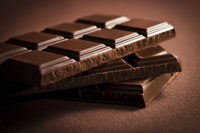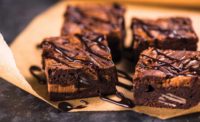How do you make chocolate better than it already is? Scientists from Temple University have found a way, and it’s pretty shocking.
The main issue that has been dogging chocolate is its high fat content. Confectioners and researchers have been looking for ways to lower the fat for decades with little success.
But in "Electrorheology leads to healthier and tastier chocolate," a study published in the Proceedings of the National Academy of Sciences, lead study author Rongjia Tao explains that the problem can be traced to chocolate in its liquid state.
When fat is removed from liquid chocolate, the viscosity or consistency changes. The altered chocolate then jams pipelines as it travels through the manufacturing process.
Tao, a professor of physics at Temple, and his team theorized that by applying an electric field to liquid chocolate, they could do two things: Reduce the viscosity enough to reduce the fat, and increase the density of the particles to maintain proper flow.
The key? Applying the electric field in the same direction as the flow of the chocolate.
Traditionally, electrorheology (ER)—the practice of using electric fields on liquids—works perpendicularly to the liquid flow direction. In this instance, the technique works by changing the alignment of particles in a liquid using electric fields. ER aggregates the cocoa solid particles into short chains, allowing scientists to reduce the viscosity and fat while maintaining flow.
Tao and his team invented their own device to test their theory, and were able to exceed their own expectations by reducing the fat content in several brands of chocolate by 20 percent.
As for how the altered chocolate tastes?
“The treated chocolate has wonderful taste,” says Tao. “Some people even claim that the ER-treated chocolate has a slightly stronger cocoa flavor, better than the original chocolate.”
Tao hopes consumers will be able to decide by themselves soon.





